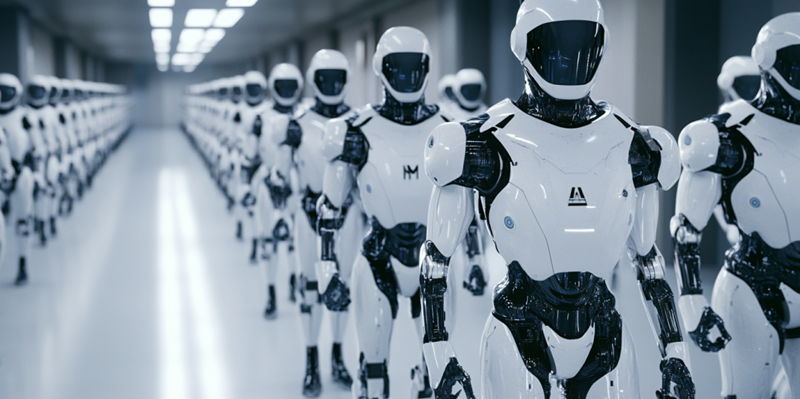Automation has come a long way since its inception, revolutionizing industries by optimizing processes and enhancing efficiency. This article delves into the fascinating journey of automation through its various generations, highlighting the transformative role of artificial intelligence in reshaping the landscape.
From Simple Bots to Smart Assistants
Automation began with simple bots designed to handle repetitive, mundane tasks. These early systems, known as Robotic Process Automation (RPA), marked the first generation of process automation. RPA was groundbreaking for its time, enabling businesses to streamline operations and free up human employees for more strategic activities.
The Beginnings of RPA
RPA introduced software bots as digital workers that could mimic human actions. These bots excelled at tasks such as data entry, form filling, and basic processing. For example, in the finance sector, RPA bots could swiftly review and process mortgage applications, significantly reducing the time and cost involved.
While RPA was a significant step forward, its capabilities were limited to structured and rule-based tasks. This generation of automation offered substantial efficiency gains but was confined to simpler workflows that did not require cognitive processing or decision-making abilities.
Advantages and Limitations
The primary advantage of RPA was its ability to handle high-volume, repetitive tasks with remarkable speed and accuracy. Businesses experienced immediate cost savings and productivity improvements. Additionally, employees could focus on higher-value tasks that required creativity and strategic thinking.
However, the limitations of RPA were evident. The bots struggled with unstructured data and dynamic environments. Tasks that required understanding context, making decisions, or processing complex information were beyond the reach of RPA, necessitating further advancements in automation technologies.
The Rise of Intelligent Automation
The second generation of process automation introduced Intelligent Automation, combining RPA with machine learning and artificial intelligence. This evolution expanded the scope of automation to include more complex workflows and unstructured data.
Integrating Intelligence
Intelligent Automation leverages AI algorithms to process and analyze unstructured content such as emails, documents, and images. In industries like healthcare, Intelligent Automation has been a game-changer. For instance, verifying patient eligibility now involves comparing multiple data sources and making informed decisions, leading to more efficient healthcare delivery.
By integrating machine learning, Intelligent Automation systems can continuously learn and improve over time. This adaptability makes them more robust and capable of handling a wider range of tasks compared to traditional RPA systems.
Transformative Impact
The impact of Intelligent Automation on organizations has been profound. Companies can now automate 30% to 40% of their workflows, compared to 20% to 30% with RPA. This increase in automation capability translates to significant cost reductions, enhanced productivity, and faster turnaround times.
Furthermore, the ability of Intelligent Automation to handle unstructured data opens up new possibilities. Businesses can automate customer support systems, fraud detection, and complex data analysis, allowing for more seamless and efficient operations.
Enter AI-Powered Automation
The latest and most advanced generation of automation is AI-Powered Automation. This generation integrates large language models (LLMs) and generative AI, enabling automation systems to perform tasks requiring cognitive abilities and contextual understanding.
The Advent of Cognitive Automation
AI-Powered Automation represents a paradigm shift in how tasks are automated. These systems can understand and generate human-like text, process natural language, and make context-aware decisions. In healthcare, AI-Powered Automation revolutionizes the credentialing process for providers, drastically reducing the time required for verification and improving accuracy.
The incorporation of LLMs and generative AI allows these systems to tackle tasks that go beyond basic automation. From drafting reports to analyzing complex datasets, AI-Powered Automation brings a new level of sophistication and capability to the automation landscape.
Expanding Horizons
With the advent of AI-Powered Automation, organizations can potentially automate 40% to 80% of their workflows. This dramatic increase in automation capability ushers in a new era of efficiency and productivity. Tasks that once required significant human intervention can now be handled autonomously by advanced AI systems.
This generation of automation also fosters innovation by freeing up human employees from routine tasks. With more time and resources available, employees can focus on strategic initiatives, creativity, and problem-solving, driving business growth and transformation.
Strategic Advantages of Advanced Automation
Automation, in its various forms, offers numerous strategic advantages for organizations. From cost savings to enhanced productivity, the benefits of embracing advanced automation technologies are multifaceted.
Cost Reduction and Efficiency
One of the most compelling advantages of automation is cost reduction. By automating repetitive and time-consuming tasks, businesses can significantly lower labor costs and operational expenses. Furthermore, automation improves process efficiency, reducing errors and ensuring consistent, high-quality output.
Enhanced operational efficiency is another critical benefit. Automated systems can handle tasks faster and more accurately than human workers, leading to faster turnaround times and improved customer satisfaction. These efficiency gains can provide a competitive edge in today’s fast-paced business environment.
Innovation and Growth
Automation has made significant strides since its early days, fundamentally transforming various industries by streamlining processes and boosting overall efficiency. This article explores the intriguing evolution of automation across different generations, shedding light on how each phase has contributed to the current state of technological advancements.
In the beginning, automation involved simple mechanical systems designed to perform repetitive tasks. Over time, advancements in electronics and computer technology ushered in more sophisticated automated systems that could handle complex operations with greater precision. The introduction of programmable logic controllers (PLCs) marked a significant milestone, allowing for more flexible and reliable automated processes.
The true game-changer, however, has been the advent of artificial intelligence (AI). AI has revolutionized automation by enabling machines to learn from data, adapt to new conditions, and even make decisions without human intervention. This has opened up new possibilities for industries ranging from manufacturing to healthcare, enhancing productivity, accuracy, and innovation across the board.
As we continue to advance, the integration of AI in automation promises to drive further progress, making our systems smarter and more efficient than ever before.

